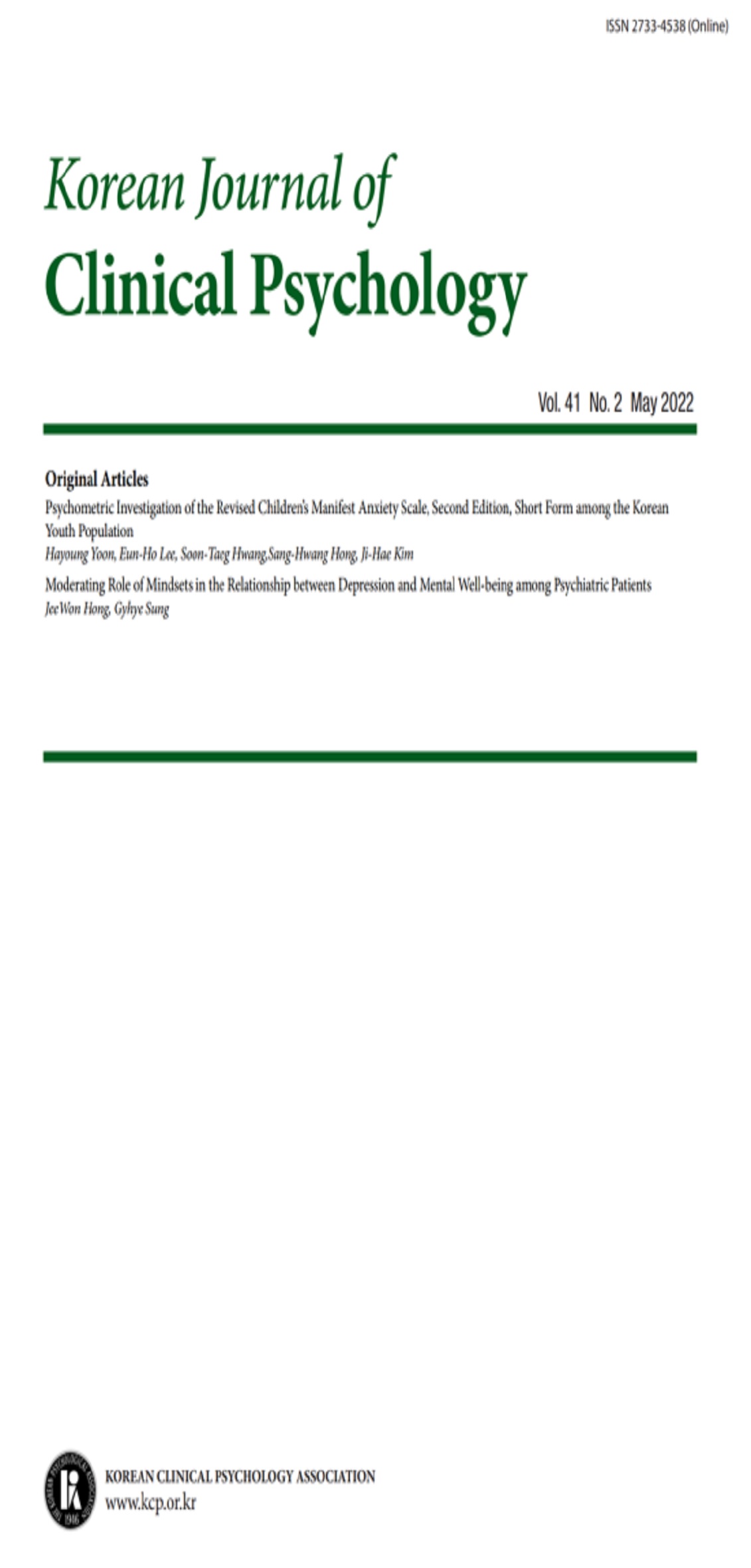open access
메뉴
open access
메뉴 E-ISSN : 2733-4538
E-ISSN : 2733-4538
This study was conducted to examine the validity and reliability of a thought suppression inventory that assesses thought suppression and intrusion separately and evaluates successive suppression as well. Factor analysis from general adults has shown that the inventory consists of three factors: suppression attempts, intrusion and successful thought suppression. The reliabilities of the 3 factors were acceptable. The thought suppression inventory was significantly associated with positive and negative affects (PANAS) and psychopathology including anxiety, depression, and obsession(SCL-(90-R). Thought suppression was also associated with a ruminative response tendency and self-concepts such as self-esteem and self-compassion. These results showed that the Korean version of the TSI has adequate psychometric characteristics and multi-facets of thought suppression. The implications of this study are discussed along with future suggestions.
김광일, 원호택, 이정호, 김광윤 (1978). 간이정 신 진단검사(SCL-90-R)의 한국판 표준화 연구 I: 정상인의 반응특성. 신경정신의학, 17, 449-458.
김경의, 이금단, 조용래, 채숙희, 이우경(2008). 한국판 자기-자비 척도의 타당화 연구: 대 학생을 중심으로, 한국심리학회지: 건강, 13(4), 1023-1044.
김은정 (1993) 우울증상 지속에 영향을 주는 인지 및 행동 변인들. 연세대학교 박사학위 청구 논문
이선영 (2010). 수용-전념 치료에서 과정변인이 불안에 미치는 매개효과. 고려대학교 박사 학위 청구 논문
이순묵 (1994). 요인분석의 관행과 문제점. 한 국 심리학회지: 산업 및 조직, 7(1), 1-27.
원호택, 이용승 (1999). 사고 억제(Thought Suppression)와 통제 방략에서의 개인차에 관한 연구. 한국심리학회지: 임상, 18(1), 37-58.
이영호 (1993). 귀인양식, 생활사건, 사건 귀인 및 무망감과 우울의 관계: 공변량 구조모형 을 통한 분석, 서울대학교 박사학위 청구 논문.
이현희, 김은정, 이민규 (2003). 한국판 정적 정서 및 부적정서 척도(Positive Affect and Negative Affect Schedule; PANAS)의 타당 화 연구. 한국심리학회지: 임상, 22(4), 935 -946.
Abramowitz, J. S., Tolin, D. F., Stresst, G. D. (2001). Paradoxical effects of thought suppression: A Meta-Analysis of Controlled studies
Amir, N., Cashman, L. Foa, E. B. (1997). Strategies of thought control in obsessive -compulsive disorder. Behavior Research and Therapy, 35, 775-777.
Becker, E. S., Rink, M., Roth, W. T., & Margraf, J. (1998). Don't worry and beware of white bears: thought suppression in anxiety patients. Journal of Anxiety Disorder, 12, 39-55.
Blumberg, S. J.(2000). The White Bear Suppression Inventory: Revisiting its factor structure. Personality and Individual differences, 29, 943-950.
Barahmand, U. (2008). Age and gender differences in adolescent worry. Personality and Individual Differences, 45, 778-783.
Brewin, C. R., & Beaton, A. (2002). Thought suppression, intelligence, and working memory capacity. Behavior Research and Therapy, 40, 923-930.
Derogatis, L. R., Rickels, K., & Rock, A. F. (1976). The SCL-90 and the MMPI: A step in the validation of a new self-report scale. British Journal od Psychiatry, 128, 280-289.
Freeston, M. H., & Ladoucer, R. (1997). What do patients do with their obsessive thoughts.? Behaviour Research and Therapy, 35, 335-348.
H.ping W., De Jong Meyer, R. (2003). Differentiating unwanted intrusive thoughts from thought suppression: What does the White Bear Suppression Inventory Measure? Personality and Individual differences, 34, 1049 -1055.
Lavy, E. H, & van den Hout, M. (1990). Thought suppression induces intrusions. Behavioral Psychotherapy, 18, 251-258.
Muris, P., Merckelbach, H., & Horsenberg, R.(1996). Individual differences in thought suppression. The white Bear Suppression Inventory: factor structure, reliability, validity and correlates. Behaviour Research and Therapy, 34, 501-513.
Melisa, R., Dugas, M. J., Conway, M. (2003). Gender differences in worry and associated cognitive-behavioral variables. Anxiety Disorder, 17. 501-516.
Meyers, L. B., Brewin, C. R. & Power, M. J. (1998). Repressive coping and the directed forgetting of emotional material. Journal of Abnormal Psychology, 107, 141-148.
Posner, M. I., & Snyder, C. R. R. (1975). Attention and cognitive control in R. L. Solso (Ed), Information processing and cognition: The Loyola symposium (pp.55-85). Hillsdale, NJ: Erlbaum..
Koster, E. H. W. (2008). How to control a white bear? Individual differences involved in selfperceived and actual thought-suppression ability. Cognition and Emotion, 22(6), 1068- 1080.
Rassin, E. (2003). The white Bear Suppression Inventory(WBSI) focuses on failing suppression attempts. European Journal of Personality, 17, 285-298.
Rassin. E., & Diepstraten, P. (2003). How to suppress obsessive thoughts. Behavior Resarch and Therapy, 41, 97-103.
Rosenthal, M. Z., Cheavens, J. S., Lejuez, C. W. & Lynch, T. R. (2005). Thought suppression mediates the relationship between negative affect and borderline personality disorder symptoms. Behaviour Research and Therapy, 43, 1173-1185.
Salkovskis, P. M. (1996). Cognitive-behavioral approaches to the understanding of obsessional problems. In: R. Rapee(Ed), Current controversies in the anxiety disorders(pp.103-133). New York: Guilford Press.
Schmit, R. E., Gay, P., Courvoisier, D., Jermann, F., Ceschi, G., David, M., Kerstin, B., & Linden, V. D. (2009). Anatomy of the White Bear Suppression Inventory(WBSI): A Review of Previous Findings and a New Approach, Journal of Personality Assessment, 9(14), 323-330.
Thrope, S. J., & Salkovskis, P. M. (1997). Animal Phobias. In: G. G. L. Davey(Ed.), Phobias: a handbook of theory, research and treatment (pp.81-105). New York: Wiley.
Watson, D. (1988). Intrindividual and Interindividual analyses of positive and negative affect. Journal of Personality and Social Psychology, 44, 644-651.
Wegner, D. M. (1989). White bears and the other unwanted thoughts: suppression, obsession, and the psychology of mental control. London: The Guilford Press.
Wegner, D. M. (1994). White bears and other unwanted thoughts: suppression, obsession, and the psychology of mental control. New York: Guilford Press.
Wegner, D. M., & Zanakos, S. (1994). Chronic thought suppression. Journal of Personality, 62, 615-640.
Wegner, D. M., Wenzlaff, R. M. (1996). Mental control. In E. T. Higgins & A.. W. Kruglanski(Eds). Social psycology: Handbook of basic principles(pp,462-492). New York: Guilford Press.
Wegner, D. M., Schneider, D. J., Carter, S. R., & White, T. L. (1987). Paradoxical effects of thought suppression. Journal of Personality and Social Psychoogy, 53, 5-13.
Wenzlaff, R. M., & Luxton, D. D (2003). The role of thought suppression in depressive rumination. Cognitive Therapy and Research, 27 (3), 293-308.
Wooten, N. R., Fakunmoju, S. B., Kim, H. & LeFerve, A. L. (2010). Factor strucutre of the Job-Related Tension Index Among Social Workers. Research on Social Work Practice, 20(1), 74-86.
Yorulmaz, D., Gencoz, T., & Woody, S. (2010). Vulnerability factors in OCD symptoms: Cross-cultural comparisons between Turkish and Canadian Samples. Clinical Psychology and Psychotherapy, 17, 110-121.
